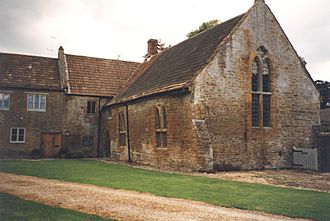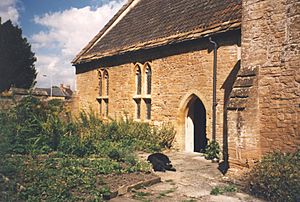Treasurer's House, Martock facts for kids
Quick facts for kids Treasurer's House |
|
|---|---|

The great hall and parlour wing.
|
|
| General information | |
| Town or city | Martock |
| Country | England |
| Coordinates | 50°58′10″N 2°46′21″W / 50.9695°N 2.7726°W |
| Completed | 13th century |
The Treasurer's House is a very old and special building in Martock, Somerset, England. It is owned by the National Trust, which is a charity that looks after important places. This house is so important that it is a Grade I listed building, meaning it has a lot of historical value. It is one of the oldest houses in Somerset, second only to the Bishop's Palace in Wells.
The house started as a 13th-century building and has been added to over many years. For example, a large hall was built in the 15th century with a special wooden roof. Inside, some rooms have old wall paintings that have been carefully cleaned and fixed. The National Trust has owned the house since 1970. Long ago, this house belonged to the Bishop of Bath and Wells. It was even used to keep the Great Seal of the Realm, which is a very important stamp used by the King or Queen, when John Langton was the Lord Chancellor (a top government official).
Contents
The Story of Treasurer's House
Early Beginnings in the 13th Century
The Treasurer's House was built in the Middle Ages as a home for a priest. It was made from a type of stone called Hamstone. The oldest part of the house, called the solar block, was built around 1250. This makes it the second oldest house in Somerset where people still live. The house was first known as the parsonage for the local Church of All Saints.
In 1227, a man named Hugh of Wells bought the house. He was the treasurer of Wells Cathedral, a big church. He also became the priest and supporter of the Martock church. A large hall was added to the house in 1293. Later, in 1297, John Langton, who was a very important person called the Lord Chancellor of England, kept the Great Seal of the Realm at the house. This shows how important the house was back then. The kitchen was added to the house in the 15th century.
Ownership Changes Over Time
The Bishop of Bath and Wells owned the building, which was also called Martock Priory, until 1849. Then, it was given to a group called the Ecclesiastical Commissioners. After that, private owners bought the house, and a small new part was added. In 1943, a man named Harold St George Gray bought it. He was a librarian and curator for the Museum of Somerset. He wanted to make sure the house was protected.
His wife later gave the house to the National Trust in 1970. This meant the house would be looked after for everyone to enjoy. In 1987, it was officially named a Grade I listed building, recognizing its special historical importance.
Exploring the House's Design
How the House Changed Over Years
The Treasurer's House has been changed and added to many times since it was first built. The building has a T-shape when you look at it from above. The part that sticks out to the west is a hall that was added in the late 13th century. The main hall has a special wooden roof from the 15th century. This roof has four sections with curved wooden supports.
The roof was once covered with slate from local stone quarries. Then, in the mid-19th century, it was covered with thatch (dried plant material). Today, the roof has clay tiles, which were put on in the early 1900s.
Different Parts of the House
The kitchen area was added in the late 15th or early 16th century. It was built separately and does not connect directly to the rest of the house. The solar block is the oldest part of the building, dating back to around 1250. It has a special window with a design called plate tracery and a three-leaf shape called a trefoil. Around this window, there are old wall paintings. The solar room is separated from the main hall by a passage called a screens passage.
Discovering Hidden Wall Paintings
In one of the private rooms upstairs, the walls were covered with a white paint called limewash from the 16th century. In 1995, this limewash was carefully removed. Underneath, they found a much older wall painting from the 13th century. This painting shows Jesus on the cross with two other figures. Another part of the painting, showing the crucifixion scene with flowers and vine leaves, was also found in the 1990s. These paintings give us a glimpse into the house's very old past.
See also
- List of National Trust properties in Somerset


